Type Ia, the oceanic type
WW2 U-Boats:
Seeteufel (1944) | Type Ia U-Boats (1936) | Type II U-Boats (1935) | Type IX U-Boats (1936) | Type VII U-Boats (1933) | Type XB U-Boats (1941) | Type XIV U-Boats (1941) | Type XVII U-Boats (1944) | Type XXI U-Boats (1944) | Type XXIII U-Boats (1944) | German mini-subs and human torpedoes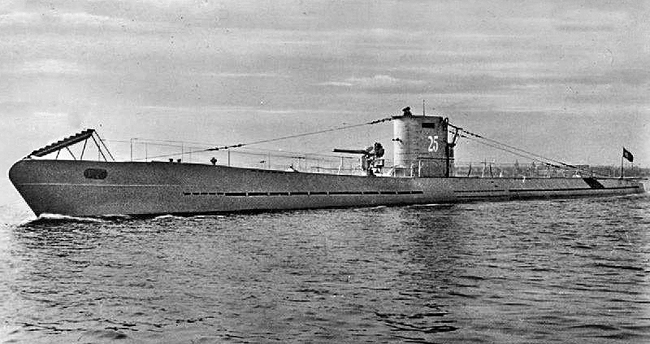
The Unterseebooten Typ I, were in direct line inspired by the Spanish E1 and various other international orders (Turkey, Finland, Holland…) made at The Hague. They were oceanic types, therefore openly violating clauses of the Versailles treaty. By their general configuration, they announced the famous class VI, with their standard features, a Kiosk with reinforced open bathtub and platform for a 20 mm AA gun, a deck gun and 6 torpedo tubes (two stern, four bow) plus powerful MAN Diesels.
However, they were little more than preseries prototypes with only two submersibles built: The U25 and the U26, testbed with some disappointing characteristics: Their MAN diesels proved troublesome, their seakeeping and maneuverability were poor. Goebbels however, used them extensively for propaganda and they were used in between for training. Both submersibles had a short but “productive” wartime career: The first sank 6 freighters before hitting a mine off the coast of Norway in August 1940. The second, U26, sank four freighters before being sunk by an escort in July 1940. The U1-U24 series had been attributed to the Type IIA coastal submersibles.
Precursors:
Finnish Vetehinen class (1930)
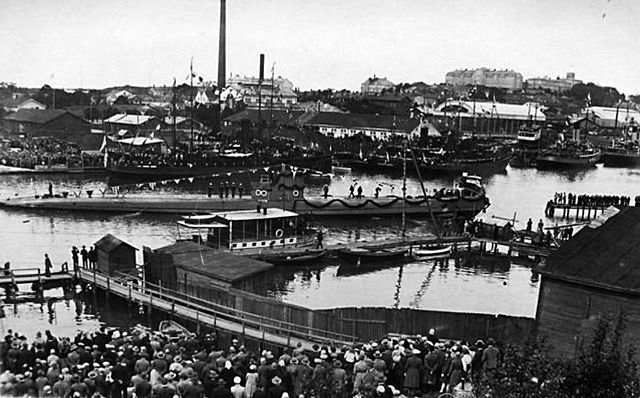
Vetehinen’s launch ceremony at Turku
Although the type was developed by the Ingenieurskantoor voor Scheepsbouw den Haag it was built in Finland, at the Crichton-Vulcan shipyard in Turku. The former was a dummy company, a subsidiary of Deutsche Schiff- und Maschinenbau AG-AG Weser established in 1920 to circumvent the Treaty of Versailles ban and maintain German engineering skills sharp in submarine design. This was an important step as the model was derived from the late WW1 era Type UB III and Type UC III. These boats were larger than usual at 6.2 m (20.3 ft) in beam (for 3.6 m/11.8 ft in draught and 63.5 m/208.3 ft in length), so a ratio of 1/10.
She was also 493 tonnes surfaced, 716 tonnes submerged. The Vetehinen class boats were indeed designed as minelaying submarines with mineshafts for 20 mines on each side and built-in inner rails for two 450 mm (18 in) torpedoes to be launched instead of the 533 mm (21 in) model, which was quite unique at that time. They were still very large stocks of that smaller caliber reserved to merchant traffic. The first was built 1926–27, launched on 1 June 1930 and commissioned on 13 October 1930. Two other boats followed, the Vesihiisi and Iku-Turso.
Spanish E1/Turkish Gür (1930)
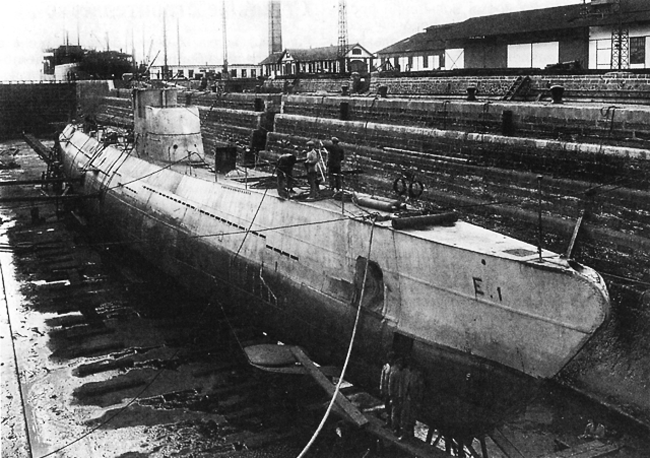
Spanish E1 in drydock at Astilleros Echevarrieta y Larrinaga in Cádiz
In 1929-30 by Astilleros Echevarrieta y Larrinaga, Cádiz in Spain produced a submarine initially ordered by Turkey. This unique boat has been designed in the Netherlands-based NV Ingenieurskantoor voor Scheepsbouw (IvS). As General Primo de Rivera’s showed interest for a submarine for the Spanish Navy, German naval officers (including Wilhelm Canaris) went to Spain to meet Spanish businessman Horacio Echevarrieta. A single order was passed in 1929 and the submarine was launched on October 1930. The new boat made her sea trials in 1931 as E-1, not commissioned yet by the Armada.
However in between, the political situation changed with the rise of the Second Spanish Republic. Immediately, alignment went back to the West and a British design was preferred. The boat was offered for sale and while Echevarrieta was jailed in October 1934, the Spanish Navy eventually sold TCG Gür to the Turkish Navy in 1935. In between, Soviet engineers tested the E-1 and, and created an improved E-2 class, known as the Soviet S class. Gür was commissioned on December 29, 1936 and served until 1947. A 650 tonnes, 72.38 m x 6.2 m x 3.48 m boat, she was considered in many aspects as the prototype of the Ia serie. Her closest counterparts back in WW1 was probably the UB III with aspects from the U93. Another posterior design that was influential to the Ia was the Swedish Delfinen class (Three boats laid down in 1933 at Kockums Mekaniska Verkstad in Malmö), and after the Ia, the 1938 Romanian Requinul and Marsuinul also incorporated some aspects of the design.
Design of the Type Ia
Both were constructed by Deschimag in Bremen, yard number 903, laid down in 1935, just after the arrival of Hitler and after the London treaty that watered down the naval conditions of Versailles and granted the Kriegsmarine some breathing space, or the 1933 Geneva disarmament conference, in which Hitler rejected the 1919 treaty clauses. The first Type IA was launched on 14 February 1936, name U-25, available after the coastal Ia-Ib series. Despite previous studies made in the Netherland and construction experience in Spain, the cost was about a hefty 4,500,000 Reichsmark. The Type VII which was derived halved that and this went far below as production was stepped up and simplified during the war.
The Type I was a relatively large oceanic type, displacing 862 t (848 long tons) on the surface, and 982 t (966 long tons) submerged for 712 tons standard as designed. It was also relatively large at 72.39 m (237 ft 6 in) by 6.21 m (20 ft 4 in) in beam and 4.30 m (14 ft 1 in) in draught. The Type VIIA of 1936 was 1/3 lighter and smaller, had a smaller gun, and one less stern torpedo tube, but it was the basis for the largest submarine series in history. In many aspects, the Type I looked like a stretched-out version of the Type VII aft. Power and range were indeed both superior. So the type should be also considered as a prototype for the enlarged Type IX of 1938, which improved the original model in all directions but had relatively similar size and capabilities, but more torpedoes and an additional 37 mm FLAK gun mount.
For propulsion, the Type Ia was given two MAN M8V 40/46 8-cylinder diesel engines rated for 2,900–3,080 PS (2,860–3,040 shp or 2,130–2,270 kW), coupled with two BBC GG UB 720/8 double acting electric motors producing 1,000 PS (990 shp or 740 kW). This allowed a top speed at the surface of 17.7–18.6 knots (32.8–34.4 km/h; 20.4–21.4 mph) and when submerged, this dropped to 8.3 knots (15.4 km/h; 9.6 mph). Diesel allowed for a good range, which was about 7,900 nmi (14,600 km; 9,100 mi) at 10 knots (19 km/h; 12 mph) on the surface, but fell to 78 nmi (144 km; 90 mi) at 4 knots (7.4 km/h; 4.6 mph) when submerged. She was dive-tested at 200 m (656 feet) but it is not known if she could have survived 250 m as some wartime U-bootes experienced.
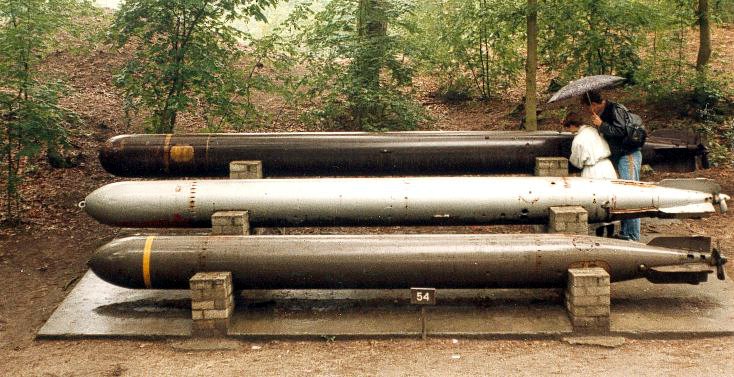
As for armament, the Type Ia possessed both bow tubes (four) and stern tubes (two) of the same caliber, 533 mm (21 in). This was a caliber fitted to sink warships, not merchant vessels. 22 G7e torpedoes were carried. The G7e type was electric, Electric with Lead-acid batteries. It was 7.16 m (23.5 ft) in length. The type carried was the first, called T2 and introduced in 1936. It can reach a target at 3000 m, running at 30 knots (56 km/h). This was not impressive as the submarine had no chance hitting a destroyer, cruisers or the new fast battleships. Instead, merchant traffic was targeted as shown by their short career. In addition, there was a 10.5 cm (4.1 in) SK C/32 naval gun, 45 calibers long, 1.8 tons, with 180 rounds in store, placed on the forward deck with a 360° traverse and 44.4° up to 80° elevation. It fired a 15.1 kilograms (33 lb) explosive (HE) shell at a 10,300-metre (33,800 ft) ceiling for AA use, while naval range was 15 kilometers (16,000 yd). The gun was enough to at least set on fire, and possibly sink a freighter. According to Conway’s, either a 2 cm Flak 30/38 or a 3.7 cm SK C/30 FLAK gun was mounted in the kiosk’s aft bathtub platform (“120 mm C30”, probably typo). However these boats were fitted with 28 × TMA mines, and did some minelaying missions.
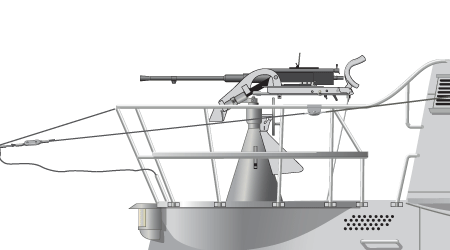
Closeup of the 2 cm FLAK 38 – credits uboat.net
The Type Ia in action
The two boats produced, U-25 and U-26, were primarily used as training vessels and for propaganda purposes. In 1939 and 1940, these boats were called into combat duty due to the shortage of available submarines. Both boats experienced short, but successful combat careers, sinking 19 ships and damaging two, but were lost in 1940.
U-25
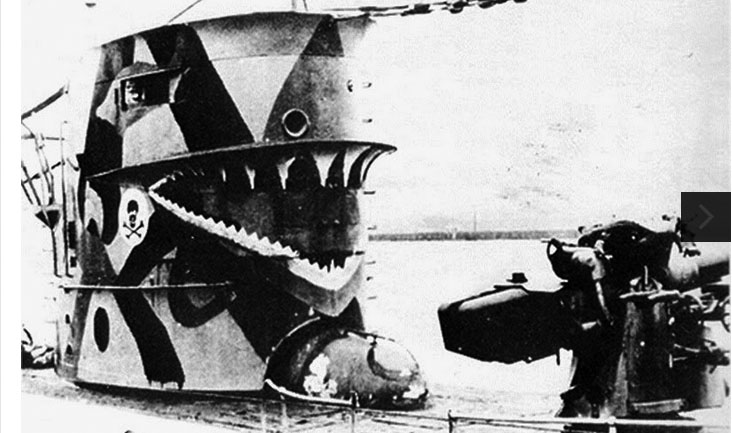
Since her commission 1940 in April 1936, U-25 has been used as a training vessel but also acted when it was required as a propaganda tool by the Nazi government. Despite the history of development before the type, U25 and 26 proved disappointing after some intensive use: As reported, this was a difficult boat to handle. Stability was at fault, as well as a slow dive rate. However early in 1940, as the war called for underwater warfare, U25 and U26 were drafted for combat missions. U-25 made five war patrols, during which she sank eight ships, leaving another badly damaging. This represented a total of 50,255 gross register tons (GRT). This was good for the start of the war and a hunting board 1944 German submariners could only dream of. However, on 1st August 1940, she was patrolling off Norway, making a minelaying operation, but went through the British mine barrage n°7, struck a mine and sank with all hands.
U-26
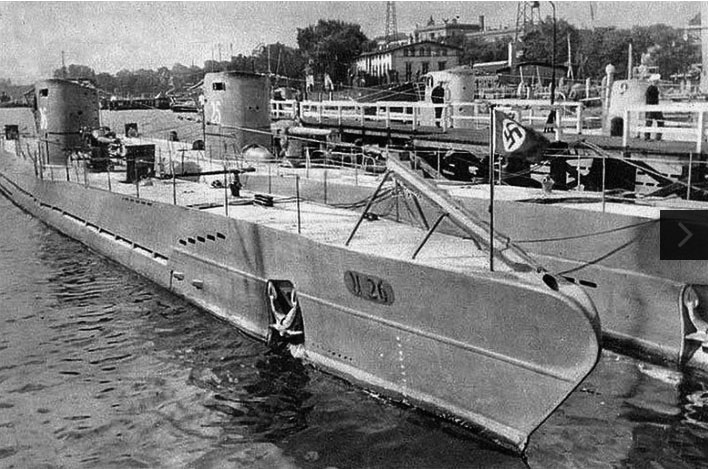
U-26, like her sister, was used as a training vessel/propaganda tool. Trials showed also the same poor handling and bad stability, slow dive rate. It seems this called for modifications. In 1940 Germany was launching an all-out submarine and surface raider campaign, and at that time, U-boats were in short supply. Therefore both experimental submarines were called to help, and started offensive missions. U-26 however, started operations in 1939.
U-26 made six war patrols, sinking eleven ships, sending a 12th to the drydock for a year.
In September 1939 she was deployed already in the Atlantic prior to the invasion of Poland. The Oberkommando der Marine (OKM) was to sent her waiting for the greenlight for a minelaying operation at Portland Harbour (Dorset, UK), commanded by Klaus Ewerth. She was refitted for the task until 28 August. She made from 4 September three attempts to evade ASW patrols before penetrating the harbor, eventually laying her mines off a point named the Shambles. This mission was quite dangerous, and she barely escaped, making her reports long after, Admiral Dönitz in between fearing she was lost, ordering to change the Enigma machine settings. But her mines sank three freighters (17,414 GRT tons total and badly damaged the corvette HMS Kittiwake in November 1939.
-On her second patrol she entered the Mediterranean Sea. She sank in February 1940 three other ships. Her fourth mission in April saw her sinking yet another freighter. Her fifth mission was in June, and she sank three more ships. In July 1940 she operated off the coast of Ireland, sinking the 4870 tons British cargo Zarian. However she was hunted down by a flower Corvette and badly damaged by depht charges southwest of Ireland, and those from an Australian Short Sunderland. She was scuttled but her crew survived and was interned in a POW camp at Duff House, Banff, Scotland.
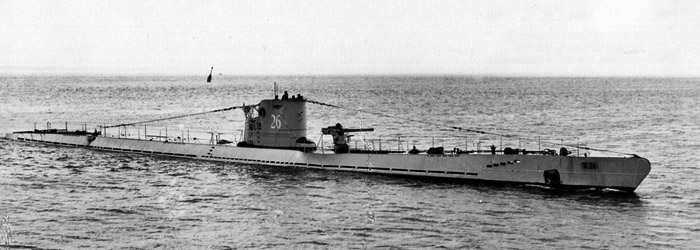
U26, photo from the Deutsche Museum
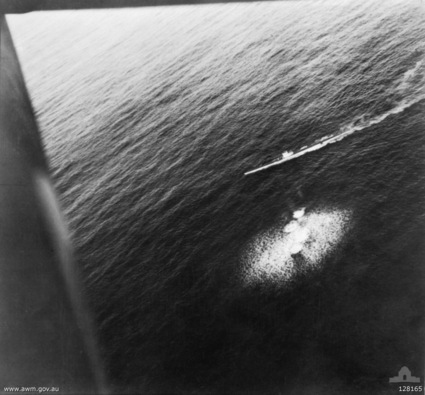
U26 shot by a RAAF Short Sunderland during attack, dodging grenades. Australian War Museum.
Specifications Type Ia
Displacement: 848t surface/970t dive
Dimensions: 72.40 x 6.20 x 4.30m
Propulsion: 2 propellers, 2 MAN boilers, 2 electric motors, 1540/500 hp. and 17.8 surface / 8.3 knots diving
Crew: 43
Armament: 1x 105 mm gun, 1x 20 mm AA gun, 6 TLT 533mm (4 av, 2 ar, 14 torpedoes)


Sources:
Conway’s all the world’s fighting ships 1922-1947
Gröner, Erich; Jung, Dieter; Maass, Martin U-boats and Mine Warfare Vessels. German Warships 1815–1945
Osprey’s Williamson, Gordon (2005). Wolf Pack: The Story of the U-boat in World War II
The Ia on uboat.net
About the Vetehinen class
About the Ingenieurskantoor vor sheepsbouw submarine desin bureau
The Type I on wikipedia
The Type I on uboataces.com
wikivisually – 1st U-boat Flotilla
pinterest’s adolfo7283 u-boote color gallery
on brendtandbrendt.com
http://www.kbismarck.com/u-boot/utyp_ia.html
http://www.heiszwolf.com/subs/plans/plans.html
http://www.rcboot.de/forum/
http://discaircraft.greyfalcon.us/Sub.htm about the IXB U112
https://www.ibiblio.org/hyperwar/USN/ref/AxisSubs/index.html
https://www.schiffsmodell.net/index.php?/forums/topic/8571-u25-von-krick/
http://www.mille-sabords.com/forum/index.php?showtopic=40300&st=25

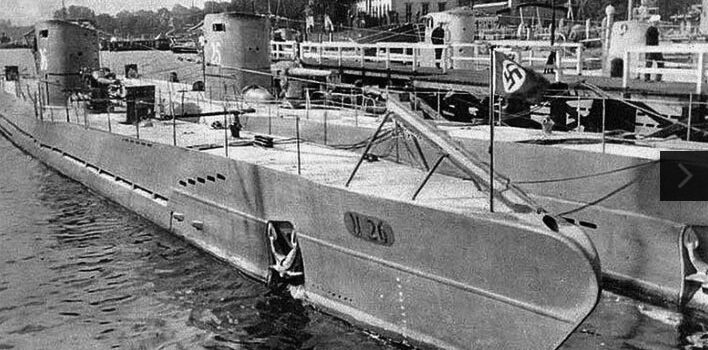

 Latest Facebook Entry -
Latest Facebook Entry -  X(Tweeter) Naval Encyclopedia's deck archive
X(Tweeter) Naval Encyclopedia's deck archive Instagram (@navalencyc)
Instagram (@navalencyc)





 French Navy
French Navy Royal Navy
Royal Navy Russian Navy
Russian Navy Armada Espanola
Armada Espanola Austrian Navy
Austrian Navy K.u.K. Kriegsmarine
K.u.K. Kriegsmarine Dansk Marine
Dansk Marine Nautiko Hellenon
Nautiko Hellenon Koninklije Marine 1870
Koninklije Marine 1870 Marinha do Brasil
Marinha do Brasil Osmanlı Donanması
Osmanlı Donanması Marina Do Peru
Marina Do Peru Marinha do Portugal
Marinha do Portugal Regia Marina 1870
Regia Marina 1870 Nihhon Kaigun 1870
Nihhon Kaigun 1870 Preußische Marine 1870
Preußische Marine 1870 Russkiy Flot 1870
Russkiy Flot 1870 Svenska marinen
Svenska marinen Søværnet
Søværnet Union Navy
Union Navy Confederate Navy
Confederate Navy Armada de Argentina
Armada de Argentina Imperial Chinese Navy
Imperial Chinese Navy Marinha do Portugal
Marinha do Portugal Mexico
Mexico Kaiserliche Marine
Kaiserliche Marine 1898 US Navy
1898 US Navy Sovietskiy Flot
Sovietskiy Flot Royal Canadian Navy
Royal Canadian Navy Royal Australian Navy
Royal Australian Navy RNZN Fleet
RNZN Fleet Chinese Navy 1937
Chinese Navy 1937 Kriegsmarine
Kriegsmarine Chilean Navy
Chilean Navy Danish Navy
Danish Navy Finnish Navy
Finnish Navy Hellenic Navy
Hellenic Navy Polish Navy
Polish Navy Romanian Navy
Romanian Navy Turkish Navy
Turkish Navy Royal Yugoslav Navy
Royal Yugoslav Navy Royal Thai Navy
Royal Thai Navy Minor Navies
Minor Navies Albania
Albania Austria
Austria Belgium
Belgium Columbia
Columbia Costa Rica
Costa Rica Cuba
Cuba Czechoslovakia
Czechoslovakia Dominican Republic
Dominican Republic Haiti
Haiti Hungary
Hungary Honduras
Honduras Estonia
Estonia Iceland
Iceland Eire
Eire Equador
Equador Iran
Iran Iraq
Iraq Latvia
Latvia Liberia
Liberia Lithuania
Lithuania Mandchukuo
Mandchukuo Morocco
Morocco Nicaragua
Nicaragua Persia
Persia San Salvador
San Salvador Sarawak
Sarawak Uruguay
Uruguay Venezuela
Venezuela Zanzibar
Zanzibar Warsaw Pact Navies
Warsaw Pact Navies Bulgaria
Bulgaria Hungary
Hungary

 Bundesmarine
Bundesmarine Dutch Navy
Dutch Navy Hellenic Navy
Hellenic Navy Marina Militare
Marina Militare Yugoslav Navy
Yugoslav Navy Chinese Navy
Chinese Navy Indian Navy
Indian Navy Indonesian Navy
Indonesian Navy JMSDF
JMSDF North Korean Navy
North Korean Navy Pakistani Navy
Pakistani Navy Philippines Navy
Philippines Navy ROKN
ROKN Rep. of Singapore Navy
Rep. of Singapore Navy Taiwanese Navy
Taiwanese Navy IDF Navy
IDF Navy Saudi Navy
Saudi Navy Royal New Zealand Navy
Royal New Zealand Navy Egyptian Navy
Egyptian Navy South African Navy
South African Navy






























 Ukrainian Navy
Ukrainian Navy dbodesign
dbodesign